June 3 - June 5: Yunnan, China
Kunming and Lijiang
We bade a fond farewell to Thailand at the Chiang Mai airport
and enjoyed a short 1 1/2 hour flight to Kunming, the biggest
city in south China's Yunnan province. Although Kunming was not
very different from other Chinese cities that we had visited, it
did have a slightly distinctive feel in that there was more
brickface on buildings and bridges than usual in China and there
were lots of hanging vines and ivy on the brick. Kunming is
called "spring city" because its climate is spring-like
all year long, with cool-ish weather and frequent rain. We lucked
out. It had rained nearly every day for the 20 days before our
arrival, but the rain subsided when we arrived.
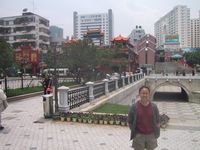 |
Downtown Kunming on a nice summer day. |
| Here's a beautiful
courtyard we found in a back alley. It was a temple, so
we didn't go in - we just poked our heads in the door. |
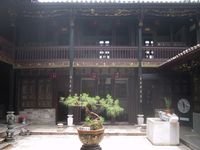 |
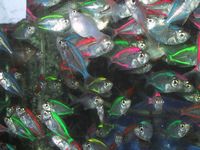 |
We found an outdoor pet market with
birds, fish, and furry creatures of every description on
sale as pets. Cool neon fish, pretty love birds, and this
really adorable puppy. |
| One of Kunming's only
reported tourist attractions is this pagoda. It was a
little tough to find, but here it is. |
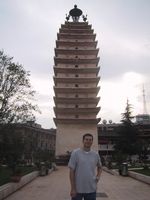 |
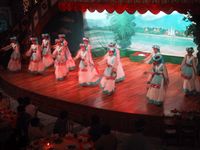 |
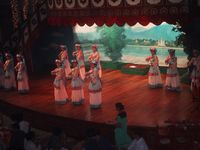 |
That evening we had a great dinner at a
restaurant theatre. In addition to the good food there
was a "minority dance" show with a variety of
costumes, dances, and singing performances. We only took
these few photos though - our hands were busy with
chopsticks for most of the performance. |
| A local tour guide we had
met in the airport on the way into Kunming had arranged
our hotel and our flight out to Lijiang. The Lijiang
airport is quite a distance from Lijiang itself and this
is what you see as you make your descent - miles and
miles of stepped rice and vegetable fields at the
foothills of the mountains. |
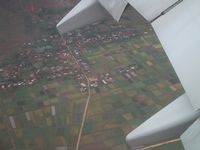 |
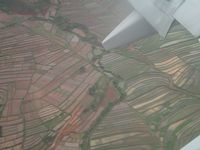 |
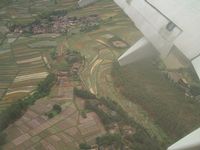 |
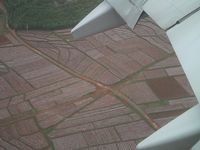 |
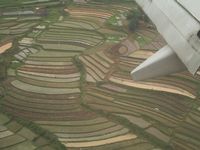 |
They certainly do make the best use of
all available land. It was amazing to stare out at all
this farmland! |
Lijiang is a very nice small city with a nondescript new
section and a beautiful, quaint old section. The city experienced
an earthquake measuring over 7 on the Richter scale in 1996. This
damaged much of Lijiang, but luckily much of the Naxi
architecture of the old section of town survived. We, along with
almost all other vistors to Lijiang, stayed in the very pretty
and quaint old section of town.
One distinctive feature of the old section of Lijiang, which
you can't see in all of these photos, is the series of small
rivers and canals crosscrossing the city. It seems that almost
every single street is accompanied by a little canal, and in
traversing the old town you are constantly walking across small
bridges and listening to the sounds of water flowing. It is
really very peaceful and beautiful. The streets are mostly
cobblestone which adds to the beauty of the area.
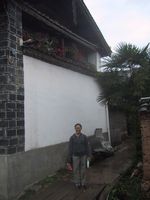 |
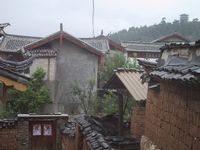 |
In the evening we bought front-row tickets for a classic Naxi
(pronounced Nah-shee) musical performance. The Naxi people are
the native Chinese minority people of the region, and they have a
very interesting social structure. It is a matriarchal society in
which women are the leaders of the family and the land owners.
Men have very little say in a traditional Naxi community, but
it's not clear how much of this old system remains in modern
Lijiang. Indeed, in every part of China that we have visited
there is a very clear parity between the sexes, and Lijiang was
no exception.
| The performer closest to
us looked like he was sleeping most of the time but he
never missed his cue when it came to playing his
instrument. |
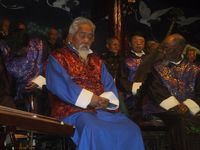 |
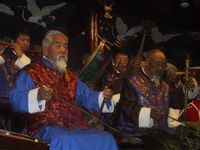 |
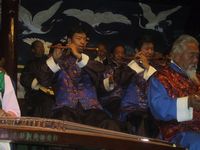 |
There was a solo flute piece by the
flutist on the right later on in the performance and it
was excellent. |
| The man on the left was
the M.C. of the event and told jokes in Chinese and
English while introducing the history behind the
orchestra and the songs before each piece. |
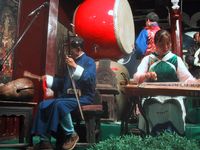 |
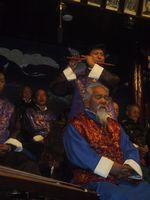 |
Here's our solo flutist doing his thing. |
| The orchestra consisted
mostly of Chinese string instruments, Chinese harps,
drums, gongs, and flutes. The Chinese harps performed a
fantastic duet at one point. |
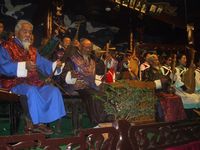 |
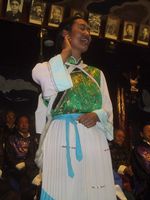 |
In our opinion this was the best part of
the show. This woman was introduced halfway through the
performance, came on from off-stage, and sang a
traditional herding song. It was hauntingly beautiful and
powerful. Her voice was strong and clear and in the front
row we were treated to an incredible performance.
Unfortunately, this was her only part in the show and
when her song was over, she walked off stage accompanied
by great applause. |
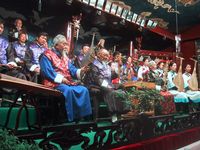
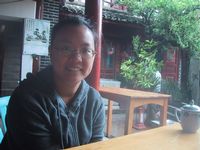 |
The next day we had breakfast in a small
nook in the old town. In addition to being a restaurant
and inn, a family also lived there. They even had a
computer! |
| It had rained a bit the
day before and this morning, but after our late
breakfast, it looked as if the sky was clearing up. So,
we rented bicycles and started out in the direction of a
famous ancient village in the area. |
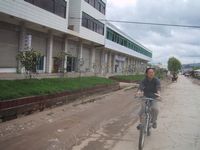 |
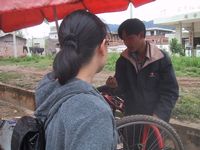 |
Nancy's bicycle had a flat tire but
luckily there was a bicycle repair man nearby. Fifteen
minutes later she was back on the road again. The charge?
One Yuan, or about 12 U.S. cents. How these bicycle
repair men make any money at all is a mystery to us. |
| After about 40 minutes of
bicycling we were halfway there. This is the outskirts of
Kunming with the mountains in the distance and the
highway stretching out of sight. |
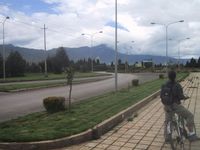 |
 Here is a panoramic view of the mountain range across the valley.
Here is a panoramic view of the mountain range across the valley.
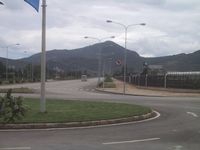 |
Getting closer ... |
| The area is a bit barren,
being a cool mountainous region. |
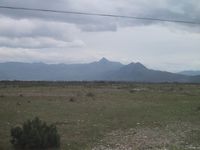 |
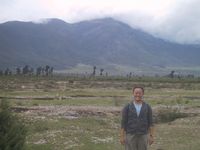 |
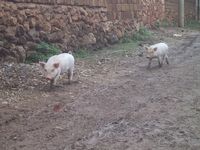 |
Finally we made it to the village. Some
piglets came out to greet us. We're not sure who shrieked
louder ... Nancy out of delight or the piglets out of
fright. |
The village itself wasn't much to speak of - it was a mostly
featureless, adorable small Chinese village. Unfortunately, like
any Chinese place that sees any amount of tourist traffic, it was
packed with street vendors selling Chinese trinkets. But
sometimes it's the journey that counts, and not the destination.
| Here's Bryan as we started
to head out of town. |
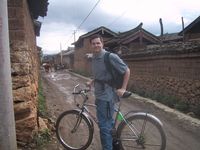 |
The ride back was magnificent because instead of taking the
major road we followed a small dirt road out of town which turned
into a winding path through the farming fields of the area. It
was peaceful, serene, and beautiful. Occasionally we saw farmers
at work in the fields, picking weeds or hoeing, and in typical
Chinese style, it was all done by hand.
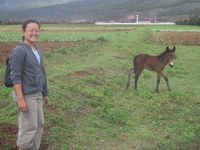 |
Nancy stopped by the side of the road to
get a closer look at this foal. |
| We happened by another
village, this one seeming very deserted. It had long,
straight dirt roads and not a soul in sight, except in
one corner of town where there was a small congregation
of men, women, and babies sitting around socializing. |
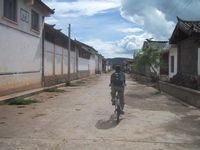 |
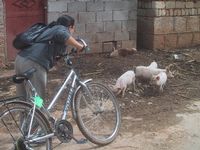 |
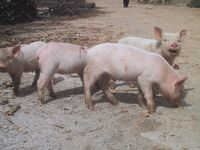 |
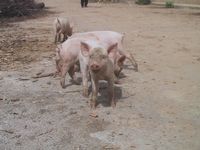 |
Nancy found some new friends. Now aren't
they just the most adorable animals?! |
| If you look very closely
you can see a small child in the distance walking towards
us. This village had a perceptible "ghost town"
feel. |
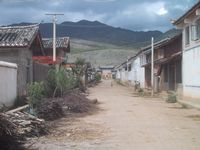 |
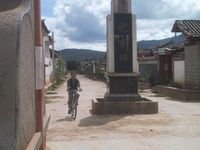 |
On our way out and back on the road. |
| Close to Lijiang we found
a reservoir which made a nice place to sit and rest. |
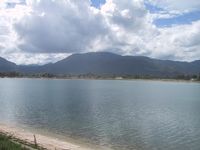 |
 |
Coming back into Lijiang we found a
giant statue of Chairman Mao greeting us. Such statues
are pretty common in China - there are several that we've
noticed around Beijing - but this one is particularly
prominent. |
In Lijiang we went the economical route and stayed in a small
Naxi hotel. The accomodations were very minimalistic - a small
room with an old bed and desk - but the courtyard was nice. The
shared bathrooms were OK, although of the eastern squat variety,
but the showers had no hot water before 9 am and as we were
leaving at 7 am it meant a very cold shower for Bryan (Nancy was
smart and showered in the evening when there was hot water).
| Reading a book outside our
room. |
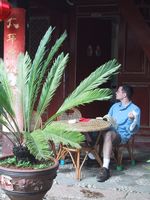 |
 Here is a view of old Lijiang from a temple
atop a small hill on the edge of town. It's quite beautiful.
Here is a view of old Lijiang from a temple
atop a small hill on the edge of town. It's quite beautiful.
We went to bed early and got a good night's sleep after a
fantastic meal at the Naxi Peasant Family Restaurant, in
preparation for the two full days hiking that was in store for us
at the Tiger Leaping Gorge.





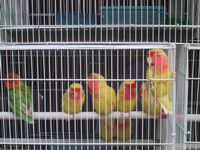
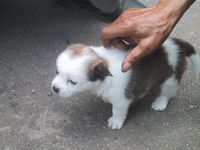
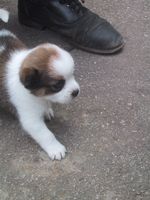




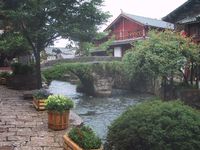
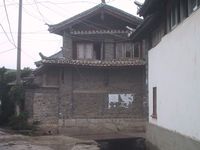










 Here is a panoramic view of the mountain range across the valley.
Here is a panoramic view of the mountain range across the valley.






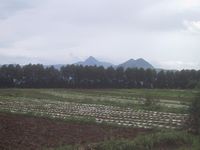







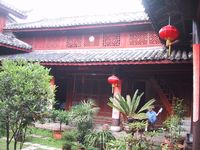
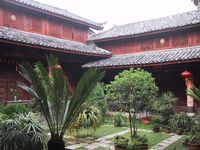

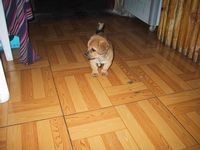
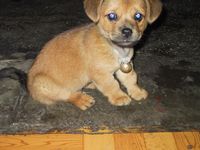
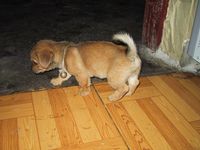
 Here is a view of old Lijiang from a temple
atop a small hill on the edge of town. It's quite beautiful.
Here is a view of old Lijiang from a temple
atop a small hill on the edge of town. It's quite beautiful.